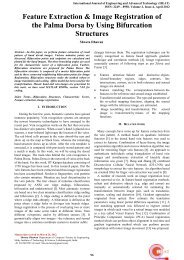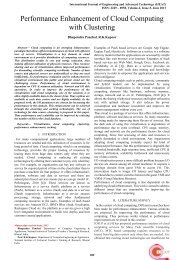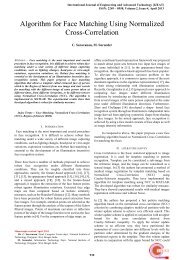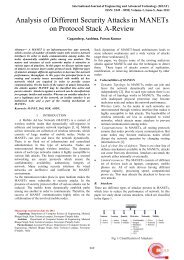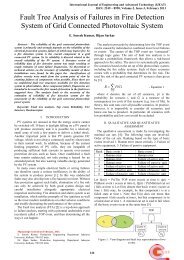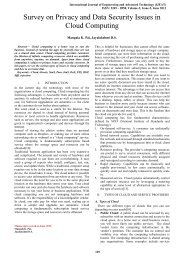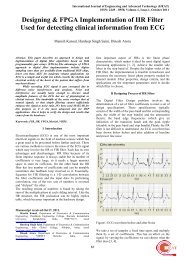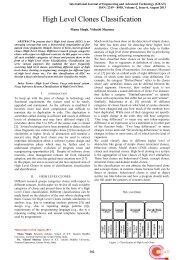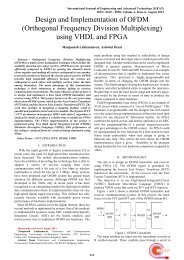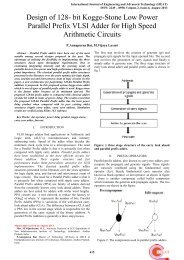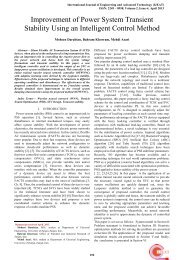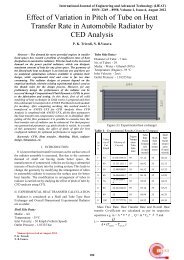FPGA Based Efficient Implementation of Viterbi Decoder
FPGA Based Efficient Implementation of Viterbi Decoder
FPGA Based Efficient Implementation of Viterbi Decoder
You also want an ePaper? Increase the reach of your titles
YUMPU automatically turns print PDFs into web optimized ePapers that Google loves.
International Journal <strong>of</strong> Engineering and Advanced Technology (IJEAT)<br />
ISSN: 2249 – 8958, Volume-1, Issue-1, October 2011<br />
V. IMPLEMENTATION RESULTS<br />
A. System level Verification<br />
In system level verification the 8 bit binary input will be<br />
feed through DIP switches to convolutional encoder which<br />
produces a 16 bit encoded output<br />
DIP switch output: 0 1 1 0 1 0 0 0<br />
Convolution encoder o/p: 00 11 00 01 01 11 10 01<br />
convolutional encoder output will be feed to <strong>FPGA</strong><br />
through 2:1 multiplexer the <strong>FPGA</strong> performs the viterbi<br />
decoding <strong>of</strong> this data by utilizing maximum likelihood<br />
method and recovers the output that is most likely as it was<br />
been transmitted.<br />
<strong>FPGA</strong> output: 0 1 1 0 1 0 0 0<br />
B. Experimental Analysis <strong>of</strong> <strong>Viterbi</strong> <strong>Decoder</strong><br />
<strong>Implementation</strong> using Traceback method:<br />
The developed <strong>Viterbi</strong> <strong>Decoder</strong> using Traceback method<br />
is implemented using VHDL and Synthesized and deployed<br />
on SPARTAN 3A XC3S400A target <strong>FPGA</strong> platform. The<br />
implemented module is tested and verified by simulation<br />
and the area utilization <strong>of</strong> <strong>FPGA</strong> is evaluated through the<br />
Synthesis Report<br />
Number used as logic 182<br />
Number used as a route-thru 3<br />
Number <strong>of</strong> bonded IOBs 14 195 7%<br />
Number <strong>of</strong> BUFGMUXs 2 24 8%<br />
4) Testing <strong>of</strong> <strong>Viterbi</strong> <strong>Decoder</strong> by Traceback Method<br />
under Noisy Conditions<br />
The functional verification <strong>of</strong> <strong>Viterbi</strong> <strong>Decoder</strong> code on<br />
<strong>FPGA</strong> done by designing a Test Bench. The Simulation<br />
result shown in waveforms below has two resultant output<br />
waveform for input stimulus i.e. Convolutional Encoded<br />
data without error and other for Convolutional Encoded data<br />
with error. This Simulation result is based on the Test Bench<br />
designed to test the ability <strong>of</strong> <strong>Viterbi</strong> <strong>Decoder</strong> code to Detect<br />
and Correct the Error. Figure shows that output <strong>of</strong> viterbi<br />
decoder is same for both.<br />
1) simulation result<br />
Figure: Test Bench Simulation waveforms<br />
C. Analytical Verification <strong>of</strong> <strong>Viterbi</strong> <strong>Decoder</strong><br />
<strong>Implementation</strong> using Register Exchange method<br />
1) RTL Schematic€<br />
2) RTL Schematic<br />
Figure: Simulation waveforms<br />
Figure 9: RTL Schematic <strong>of</strong> <strong>Viterbi</strong> <strong>Decoder</strong> using<br />
Traceback Method<br />
3) Advanced HDL Synthesis Report<br />
Device Utilization Summary<br />
Logic Utilization<br />
Used Available Utilization<br />
Total Number Slice Registers 98 7,168 1%<br />
Number used as Flip Flops 97<br />
Number used as Latches 1<br />
Number <strong>of</strong> 4 input LUTs 182 7,168 2%<br />
Logic Distribution<br />
Number <strong>of</strong> occupied Slices 133 3,584 3%<br />
Number <strong>of</strong> Slices containing<br />
only related logic<br />
Number <strong>of</strong> Slices containing<br />
unrelated logic<br />
Total Number <strong>of</strong> 4 input<br />
LUTs<br />
133 133 100%<br />
0 133 0%<br />
185 7,168 2%<br />
Figure: RTL Schematic<br />
2) Advanced HDL Synthesis Report<br />
Logic Utilization<br />
Device Utilization Summary<br />
Used Availa<br />
ble<br />
Utilizatio<br />
n<br />
Number <strong>of</strong> Slice Flip Flops 1,910 7,168 26%<br />
Number <strong>of</strong> 4 input LUTs 2,922 7,168 40%<br />
Logic Distribution<br />
Number <strong>of</strong> occupied Slices 2,395 3,584 66%<br />
Number <strong>of</strong> Slices containing only<br />
related logic<br />
Number <strong>of</strong> Slices containing<br />
unrelated logic<br />
2,395 2,395 100%<br />
0 2,395 0%<br />
Total Number <strong>of</strong> 4 input LUTs 3,064 7,168 42%<br />
88



